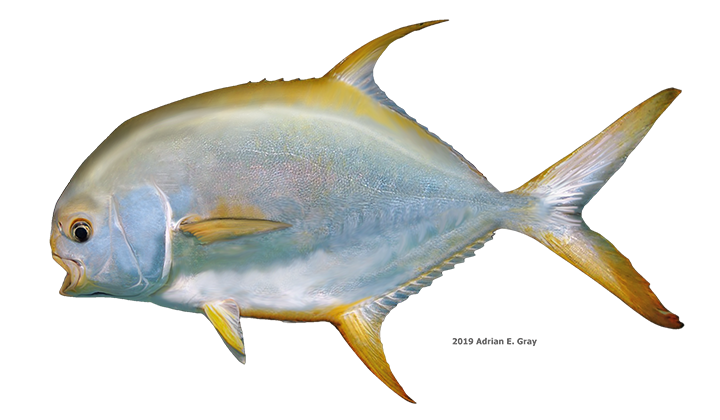Game Fish Identification Reference Guides
Pompano, snubnose
(Trachinotus blochii)
(Trachinotus blochii)

(Lacepède, 1801); CARANGIDAE FAMILY; also called lune, pampe, oyster cracker and snubnose dart
Snubnose pompano are members of the jack family and are one of 20 species that comprise the Trachinotus genus of pompanos. They are an Indo-Pacific species with a longitudinal distribution from the Red Sea and East Africa to the Marshall Islands and Samoa. Snubnose pompano occur as far north as southern Japan and as far south as Australia. They can be encountered on shallow flats less than a meter deep down to depths of over 50 meters. Snubnose pompano can also tolerate a wide range of salinities, which allows them to occupy habitats ranging from estuaries to coral reefs.
Snubnose pompano closely resemble their relative the permit (Trachinotus falcatus) that occurs in the western Atlantic. It can be distinguished from other large pompanos in their range (i.e., T. mookalee, T. anak, T. africanus) by its exceptionally long dorsal fin that can be as much as 60% of the fish’s fork length. The body is silvery in coloration with the dorsal and ventral portions often having a yellowish cast that extends to the dorsal and anal fins.
Like most members of the Carangidae family, snubnose pompano are fast swimmers and hard fighters, which makes them popular with anglers. Because they often occur in shallow water, they provide excellent sight fishing opportunities for anglers fishing with fly and light tackle. They feed primarily on hard-shelled invertebrates such as crabs, shrimp and clams that they crush with well-developed pair of pharyngeal jaws located in the back of their throat.
Snubnose pompano are members of the jack family and are one of 20 species that comprise the Trachinotus genus of pompanos. They are an Indo-Pacific species with a longitudinal distribution from the Red Sea and East Africa to the Marshall Islands and Samoa. Snubnose pompano occur as far north as southern Japan and as far south as Australia. They can be encountered on shallow flats less than a meter deep down to depths of over 50 meters. Snubnose pompano can also tolerate a wide range of salinities, which allows them to occupy habitats ranging from estuaries to coral reefs.
Snubnose pompano closely resemble their relative the permit (Trachinotus falcatus) that occurs in the western Atlantic. It can be distinguished from other large pompanos in their range (i.e., T. mookalee, T. anak, T. africanus) by its exceptionally long dorsal fin that can be as much as 60% of the fish’s fork length. The body is silvery in coloration with the dorsal and ventral portions often having a yellowish cast that extends to the dorsal and anal fins.
Like most members of the Carangidae family, snubnose pompano are fast swimmers and hard fighters, which makes them popular with anglers. Because they often occur in shallow water, they provide excellent sight fishing opportunities for anglers fishing with fly and light tackle. They feed primarily on hard-shelled invertebrates such as crabs, shrimp and clams that they crush with well-developed pair of pharyngeal jaws located in the back of their throat.













